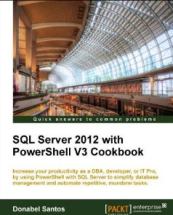If you’re curious, you can rename the .ispac file and give it a .zip extension, and extract. Voila, we see all the files that make up the ispac – a manifest, your DTSX files, and a .param file. Also note that the manifest does not have the usual uber-long .ssisDeploymentManifest extension
Archive for May, 2012
1 Comment
Filed under:
SSIS
In order to work with report items with SQL Server Reporting Services 2008, most of the time you need to get a handle to the report items.
Here is a sample code snippet that uses the ReportingService2010 web service and PowerShell V3 CTP.
cls #replace this with your reportserver web service URI $ReportServerUri = "http://localhost/ReportServer/ReportService2010.asmx"; $proxy = New-WebServiceProxy -Uri $ReportServerUri -UseDefaultCredential ; #we'll use the ListChildren method to navigate through all your SSRS items #the $true parameter specifies recursive navigation $catalogitemsarray = $proxy.ListChildren("/", $true); $reportpath = "/Customers/Customer Contact Numbers"; $report = $null; foreach ($catalogitem in $catalogitemsarray) { if($catalogitem.Path -eq $reportpath ) { $report = $catalogitem; } } #display properties $report |
Sample result is as follows:
ID : 15b3dd87-d0de-43a0-8692-030dcfdab945
Name : Customer Contact Numbers
Path : /Customers/Customer Contact Numbers
VirtualPath :
TypeName : Report
Size : 23870
SizeSpecified : True
Description :
Hidden : False
HiddenSpecified : False
CreationDate : 5/13/2012 12:13:48 AM
CreationDateSpecified : True
ModifiedDate : 5/13/2012 12:13:48 AM
ModifiedDateSpecified : True
CreatedBy : KERRIGANAdministrator
ModifiedBy : KERRIGANAdministrator
ItemMetadata : {}
Filed under:
musings
Just a short snippet to dynamically generate a database snapshot script. Could be useful especially if your database has multiple files and/or filegroups:
-- run with "Results in Text" mode DECLARE @dbname VARCHAR(100) = 'SampleDB' -- we will timestamp both the snapshot name and the files DECLARE @currdate VARCHAR(20) SET @currdate = '_' + CONVERT(VARCHAR(20), GETDATE(), 120) SET @currdate = REPLACE(@currdate, ':', '') SET @currdate = REPLACE(@currdate, '-', '_') SET @currdate = REPLACE(@currdate, ' ', '_') DECLARE @SQL VARCHAR(MAX) SET @SQL = '' SELECT @SQL = COALESCE(@SQL + ('(NAME=' + [name] + ',FILENAME=''C:TempSnapshots' + [name] + @currdate + '.ss''),'), '') FROM sys.database_files WHERE type_desc = 'ROWS' ORDER BY [file_id] -- need to remove last comma SET @sql = LEFT(@sql, LEN(@sql) - 1) SELECT 'CREATE DATABASE '+ @dbname+ @currdate+' ON ' + @sql + ' AS SNAPSHOT OF ' + @dbname |
Filed under:
musings





